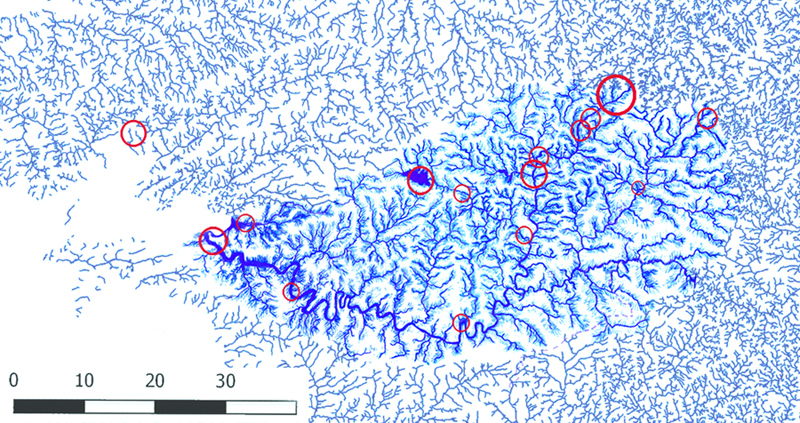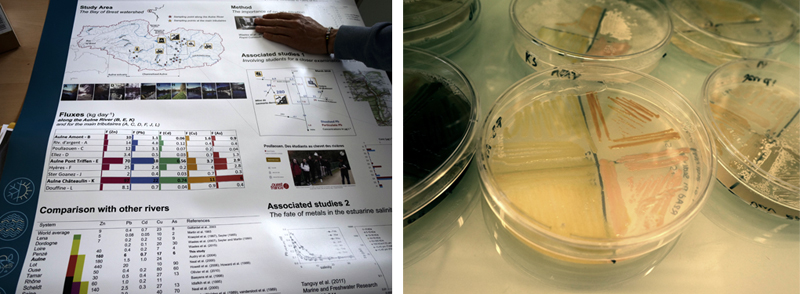Surveys on the river watershed: August 2022 – May 2023 <
These investigations allow me to measure the feasibility of the course on the Aulne and its tributaries, such as the Ellez and the Hyères.The Aulne alone is more than three times the size of the Gouët, the first river tracked in 2012, which gives the measure of the work to be done.

Aulne maritime, au-dessus de Landevennec, Finistère

Sites explores entre aout 2022 et fin 2023
Meetings at the LEMAR <
Collaboration with scientists of the LEMAR during the IRP CLIMCLAM
The International Research Program CLIM CLAM divises into 4 research axis:
AR1: Dynamics and evolution of the diversity of microparasite communities
AR2: Host responses to various environmental conditions in synergy or not
with diseases
AR3: Food Safety
AR4: Transdisciplinary approaches: Environmental Anthropology, Art and Sciences
It is under the joint direction of Christine Paillard (LEMAR, CNRS, University of Western Brittany) in France, world specialist in clam diseases, and Luca Barcelloni (University of Padua, BCA UNIPD) in Italy.
Meetings during 2022
• April
Presentation at the IUEM of around fifteen CLIMCLAM speakers by research
axis. French team and Italian team.
• June
Visit to the IFREMER experimental site in Argenton: oyster nursery, algae
cultures... The site will host clams for CLIMCLAM.
• November
“Healthy” clams from a Norman farm are swarmed in the harbor of
Brest. A tenth is sacrificed in order to serve as witness free of any link
with the harbor of Brest: organ and hemolymph samples.


Meetings in 2023
• February
AR4 Overview and Organization
• March
Arts-Sciences Festival conferences.
Clam Biology
• April
Meeting of Gwenaêlle
Le Blay and Stéphanie
Madec around their MARESISTOME
project within CLIMCLAM: antibiotic resistance analyzed using DNA and bacteria
samples in the salivary glands of clams fished in the Faou estuary, where
the Aulne flows but also part of anthropogenic elements of Brest harbor.
Meeting with Mathieu Waèlès, chemist at LEMAR. Sampling of metalloids (heavy metals such as lead, cadmium, but also zinc, arsenic, etc.) taken in the Aulne watershed, near a former silver-lead mine (Huelgoat).

Meeting with Vianney Pichereau, collaborative project "Integration of environmental signatures and omics-based approaches on the European flounder to assist with health assessment of estuarine ecosystems in Brittany" which consists of accounting through molecular biology for different pollutions (the flagship pollutions: metals , pesticides, nitrates, phosphates) in the watershed of small coastal rivers in Brittany. Alder will be considered in this study.
Training on brown ring disease, Christine Paillard.
• May
Conference of undergraduate chemistry students at UBO and students at the
Lesneven agricultural high school on lead, arsenic, and nutrient pollution.
Samples were taken from the tributary watercourses of the Aulne. Lesneven
agricultural high school organization, Mathieu Waèlès.
Meetings in 2024
• January
With Christine Paillard, first glimpse of clam organ cuts (historical since
the 80s)
Webinar with the entire Franco-Italian CLIMCLAM team, presentation of River's Memory (here)
• March
Site of the Huelgoat silver lead mine with Matthieu Waèlès
and teachers from the Chateaulin agricultural high school and their students.
Meetings on the territory<
Technicians from the Public Establishment for Development and Management
of the Aulne watershed, EPAGA
November 2022
EPAGA supports the contribution of an artistic approach to the Brest harbor
contract.
Management of the Scientific Committee, Brest Harbor Contract
December 2022
The contract sets out its objectives from 2023 to 2027. The goal is to improve
the preservation of biodiversity and water quality.
Waters and Rivers of Brittany
September 2022
Culture Commission of "Eaux et Rivières de Bretagne": presentation
of the Rivermemory project, article in the E&RB Magazine.
Living Brittany
April 2023
Meeting with two naturalists from "Bretagne Vivante" in particular
responsible for monitoring the pearl mussel (freshwater mussel) on the Ellez.
Individuals, fishermen, farmers...: 2024